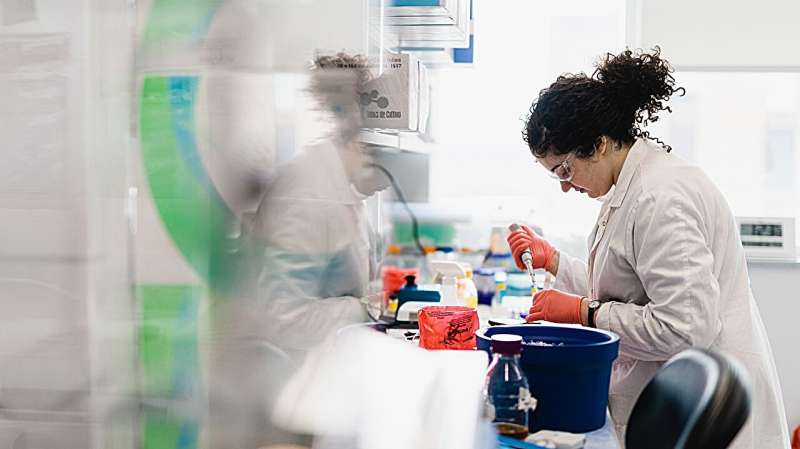Hannah Zurier, then a graduate student, works in professor Julie Goddard's food science lab. Credit: Allison Usavage / Cornell University
There are over 5 billion tons of plastic waste accumulated across the planet, much of which are microplastics that may harm human health and pose a long-term threat to agricultural productivity and food security. The gargantuan task of cleaning up this pollution could be aided by a tiny protein: a specialized enzyme designed to break down plastics into simple components that natural bacteria in the environment can use as a food source.
Julie Goddard, professor of food science, and her research team are engineering a unique enzyme that targets polyethylene terephthalate (PET), a common plastic used in packaging and textiles. Her lab has successfully engineered a new enzyme capable of breaking down plastic in the complex conditions found in sewage sludge, and she envisions a system in which these enzymes could someday help reduce microplastics in treated wastewater. Microorganisms are regularly used in wastewater treatment. This work was inspired by former graduate student Hannah Zurier, Ph.D., now a postdoctoral research scientist at Columbia University, and continues with doctoral candidate Sonia Su, Goddard said.
Wastewater treatment plants are a major source of microplastic pollution into the environment—and into agricultural fields. To avoid overuse of freshwater resources, and in recognition of growing global water scarcity, treated wastewater effluent is increasingly being used for agricultural irrigation. Although there is more public attention on microplastic pollution in oceans than in soils, far more microplastics are released into soils each year: four to 23 times as much.
"Wastewater reuse is an important strategy in the global fight against water scarcity, but it demands that the wastewater is free of contaminants, including microplastics," Goddard said.
Microplastics—defined as plastic particles 5 mm or smaller—harm agriculture in myriad ways. They limit soil microorganisms' movement and access to nutrients, which in turn disrupts the microbes' critical role in soil nutrient cycling necessary for plant development. Microplastics in soil are absorbed directly into plants' seeds, roots and vascular systems, disrupting their ability to uptake water and nutrients, and passing through to the animals and humans who consume them.
The enzyme Goddard's lab is working with evolved within the bacteria Ideonella sakaiensis, which breaks down PET plastics in nature. It was discovered by a team of Japanese scientists outside a landfill and reported in Science in 2016. Since then, scientists have been scrambling to discover and engineer similar enzymes that can biodegrade plastics more quickly and under a range of conditions. Goddard's goal is to engineer enzymes that can break down microplastics into small products that can be used as energy sources for bacteria used in the wastewater treatment process.
Think of these enzymes like precisely folded beaded necklaces, Goddard said; they're made up of strings of amino acids that can be changed so they fold in different ways, depending on what you want them to do. But while the metaphor is simple, the science certainly isn't: adapting these enzymes to work in the conditions present in sewage sludge requires genome sequencing the enzymes, running those sequences through complex software packages to identify which amino acids are most responsible for performing the tasks you want them to perform, engineering a huge number of potentially useful variants, and then building and testing those variants in the lab.
In addition, the conditions that exist in wastewater treatment are very different from conditions where the wild enzyme evolved—and can vary significantly from one facility to another—with wastewater treatment having higher temperatures and levels of organic material, and variable pH levels.
Goddard's lab is also working on a variant enzyme that can attach onto materials common in wastewater filters, which would enable recovery and re-use of these enzymes.
Since beginning her research on this topic in 2018, the need for microplastic removal has only increased. A groundbreaking study in January reported that there is 10 to 100 times as much microplastic in bottled water as previously believed, and the United Nations is currently debating an international treaty to limit plastic pollution.
"Water is a commodity that we know very well is limited," Goddard said. "We need to figure out how to remove microplastics from wastewater for it to be a viable alternative to freshwater use. In addition to health and environmental concerns, this is essential for the long-term economic sustainability of agriculture."
Journal information: Science
Provided by Cornell University
























